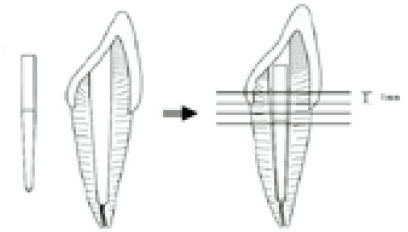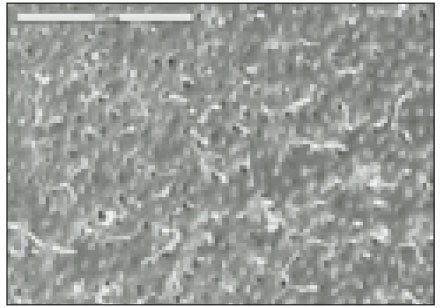Microtensile bonding of resin fiber reinforced post to radicular dentin using resin cement
Article information
Abstract
Object
The purpose of this study were to evaluate the microtensile bond strength of resin fiber reinforced post to radicular dentin using resin cement according to various dentin surface treatment and to observe the interface between post and root dentin under SEM.
Material and Method
A total 16 extracted human single rooted teeth were used.
A lingual access was made using a #245 carbide bur in a high-speed handpiece with copious air water spray. The post space was mechanically enlarged using H-file(up to #60) and Gates Glidden bures(#3). This was followed by refining of the canal space using the calbrating drill set provided in ER Dentinpost(GEBR, BRASSELER GmbH&Co. KG).
The 16 teeth were randomly distributed into 4 group of 4 teeth.
Group 1 teeth had their post space prepared using 10% phosphoric acid as root canal surface treatment agent during 20s. The canal was then rinsed with saline and dried with paper point.
Group 2 teeth had their post space prepared using 3% NaOCl as root canal surface treatment agent during 30min. The canal was then rinsed with saline and dried with paper point.
Group 3 teeth had their post space prepared using 17% EDTA as root canal surface treatment agent during 1min. The canal was then rinsed with saline and dried with paper point.
Group 4 teeth had their post space prepared using 17% EDTA as root canal surface treatment agent during 1min. After rinsing with saline, the canal was rinced 10ml of 3% NaOCl for 30min.
After drying with paper point, the post(ER Dentinpost, GEBR, BRASSELER GmbH&Co. KG) was placed in the treated canals using resin cement. Once the canal was filled with resin cement(Super bond C&B sunmedical co. Ltd.), a lentulo was inserted to the depth of the canal to ensure proper coating of the root canal wall.
After 24 hours, acrylic resin blocks(10·10·50mm) were made. The resin block was serially sectioned vertically into stick of 1·1mm. Twenty sticks were prepared from each group. After that, tensile bond strengths for each stick was measured with Microtensile Tester.
Failure pattern of the specimen at the interface between post and dentin were observed under SEM.
Results
1. Tensile bond strengths(meen±SD) were expressed with ascending order as follows ; group 4, 12.52±6.60 ; group 1, 7.63±5.83 ; group 2, 4.13±2.31 ; group 3, 3.31±1.44.
2. Tensile bond strengths of Group 4 treated with 17% EDTA +3%NaOCl were significant higher than those of group 1, 2 and 3 (p<0.05).
3. Tensile bond strengths of Group 1 treated with 10% phosphoric acid were significant higher than those of group 2 (p<0.05). Tensile bond strengths of Group 4 treated with 17% EDTA +3% NaOCl was significant higher than those of other groups.


















